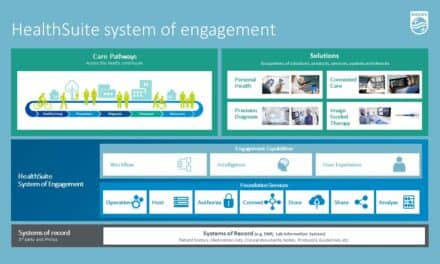By Puneet Pandit and Frank Beltre
The pressures facing healthcare delivery organizations are well documented: increased regulatory oversight, financial challenges, heightened competition, a shrinking talent pool, and many more. Also well known is the army of consultants, systems integrators and technology companies promising their solutions will address one or more of these market trends. All too often, implementation fails to deliver the promised results, leaving the healthcare organization with a big bill and little to show for it.
What if there were new solutions, built on the powerful capabilities of artificial intelligence and machine learning (AI/ML) that provided proven, quantifiable cost savings of 30% or more, and consistent improvements in uptime for some of the most expensive equipment healthcare facilities operate?
Harbor Research, a leading strategy and technology research firm, notes utilizing AI/ML to leverage complex machine data from healthcare imaging equipment alone will provide $11.1 billion in revenue value (decreased costs/increased revenue generation) by 2022.
AI/ML have the potential to positively disrupt how healthcare organizations use data. Effectively leveraging equipment data enables healthcare delivery organizations to:
- Maximize machine uptime; reduce costs and optimize revenue.
- Meet more stringent standards for medical equipment maintenance.
- More rapidly train technical staff and monitor staff performance.
- Track equipment utilization rates.
- Determine capital purchase needs.
“We have recently adopted what we consider a game-changing AI/ML solution to help us facilitate service management, asset utilization and performance improvement, all as part of the UCSF Health’s 2020 strategic goals,” says Ramana Sastry, director of clinical engineering at UCSF Health. “Reducing or eliminating costs of service level agreements for parts, software and service, based on service intelligence derived from AI/ML provide cumulative metrics for each imaging system.
How AI/ML Works for Complex Equipment
Today’s medical equipment systems produce increasing amounts of complex machine data that require more advanced data transformation solutions. Some of the data is structured, some is semi-structured and some is unstructured. Advanced AI/ML can now provide insights far beyond basic diagnostics to help healthcare providers anticipate and address equipment failures and maintenance.
Moreover, today’s industry standard of 96%-98% machine uptime can be increased to more than 99.5%, resulting in millions of dollars per year in reclaimed revenue from operational budgets. A critical element in improving machine uptime is the ability for AI/ML to help clinical engineers anticipate and plan for equipment maintenance, versus waiting for a malfunction and then addressing the problem.
AI applications powered by machine learning models are being used to predict part failures in expensive imaging modalities, revolutionizing the landscape of how equipment maintenance is performed today by in-house support staff.
Revenue Maximization Is the Name of the Game
Healthcare delivery organizations must be intently focused on maximizing the uptime of their machines to earn maximum revenue and provide optimal patient care. Downtime for expensive equipment is a revenue death spiral for healthcare organizations.
Here’s an example of how much those costs can total: an MRI machine can provide $3,500 in revenue per hour of service. If a machine goes down for 24-48 hours, the cost to the hospital ranges from $84,000 to $168,000. Assuming the system goes down five or six times per year, the annual downtime cost is $420,000 to $1,008,000. If the healthcare delivery organization has 30 MRI machines, the total annual downtime cost is $12,600,000 to $30,240,000. If the facility can reduce repair time to four to six hours and each machine only goes down two or three times per year, the annual costs drops dramatically to a range of $840,000 to $1,890,000.
Another revenue drain is policies regarding frequency of parts replacement. OEMs may state certain critical parts in their MRI and CT scanners should be checked and replaced every few months as part of a preventive maintenance (PM) schedule. However, these parts can malfunction at any point in time, depending upon hundreds of operational machine data parameters inside these machines. A good example is an x-ray tube in a CT scanner.
Many times provider organizations procure x-ray tubes three months in advance as part of their budgetary cycle without any data driven inputs on a machine’s actual health. They end up replacing tubes when actually the fault lies in some other mechanical part of the system. Optimal replacement times for parts should instead be reliant on several data inputs based on the age of the machine, number of scans performed, image quality rendered and other machine data signals. Without proper diagnostics, many healthcare organizations incur extra costs from either excessive downtime or needless replacement of expensive parts.
Increased regulation can also hinder revenue optimization. In 2013, the Centers for Medicare and Medicaid Services (CMMS) and other accreditation agencies, revised their equipment maintenance standards. They now require that hospitals must strictly follow all OEM maintenance recommendations on all equipment.
OEMs tend to be conservative in their maintenance recommendations to avoid legal liability. This strains a facility’s budget in two ways: First, increased maintenance negatively impacts the hospital’s budget by requiring machines be taken off line more frequently, and, as noted above, replacing parts on a time basis versus a needs basis can end up costing the hospital more.
A third benefit of deploying AI/ML to leverage machine log data involves personnel. Many experienced clinical engineers are retiring or otherwise leaving healthcare delivery organizations. With the unemployment rate at an 18-year low of 3.9%, it can be difficult to find qualified replacements. Predictive and prescriptive analytics generated by AI/ML solutions can provide both insights into machine performance, as well as direct more junior clinical engineers what activity is required to ensure maximum uptime.
In addition, AI/ML solutions monitor the performance of equipment while clinical engineers are performing scans and other services, and can offer insights into how the engineers can improve their efficiency.
“Anticipating and addressing performance anomalies of expensive imaging equipment before they result in downtime should be a key goal of any AI/ML deployment inside a healthcare delivery organization,” says Glen Allmendinger, president and founder of Harbor Research, among the first analyst firms to focus on smart systems and services, and the Internet of Things. “Machine data can provide highly useful insights for a wide range of efficiency issues, such as training new staff to manage sensitive equipment.”
Real-Life Examples Illustrate AI/ML Value
Innovative healthcare delivery organizations are turning to AI/ML to address these and other challenges they face today. The following three examples are brief illustrations of the equipment performance improvement and potential cost savings achieved to date.
- An AI/ML solution detected a serious anomaly in magnet pressure of an MRI machine, trending over the 2017 holiday week between Christmas and New Year’s. As a result of the AI/ML solution highlighting the anomaly, a field engineer investigated and found a power outage had occurred. By restoring the power quickly, the facility avoided a $15,000 cryogen refill, a potential quench and three to four days of downtime and $50,000 revenue loss.
- In another situation, an AI/ML solution revealed an abnormal number of arcs and aborts on a CT scanner over a two-day period. By discovering this anomaly early, a field engineer was able to schedule replacement of the CT tube, which was still under warranty, during a planned downtime window. As a result, the facility enjoyed a more than 50% reduction in mean time to resolution for service tickets, leading to higher machine uptime and no loss in revenues.
- In yet another scenario, an AI/ML solution recognized that the cold head temperature in an MRI machine shot up normally within moments of a shutdown of the helium compressor. A field engineer quickly replaced the helium adsorber, which if it had failed would cause a premature cryogen boil off, leading to a potential quench. Here, the AI/ML solution avoided a $15,000 cryogen refill and $50,000 in potential down time.
How to Get Started
Administrators, medical staff, and healthcare delivery organization IT teams are often concerned about deploying new solutions for fear of equipment downtime, legal liability, regulatory non-compliance, and other factors. Today’s leading AI/ML solution providers often include teams that can make the deployment rapid and seamless.
For the opportunity to disrupt current maintenance practices, save 30% (or more) in maintenance costs of expensive and delicate equipment, and provide better patient care in the process, more innovative leaders are jumping on the AI/ML bandwagon daily.
Puneet Pandit is CEO of Santa Clara, Calif.-based Glassbeam, Inc., and Frank Beltre is service operations consultant at Castle Rock, Colo.-based QDC Biomedical, LLC. Questions and comments can be directed to 24×7 Magazine chief editor Keri Forsythe-Stephens at [email protected].





